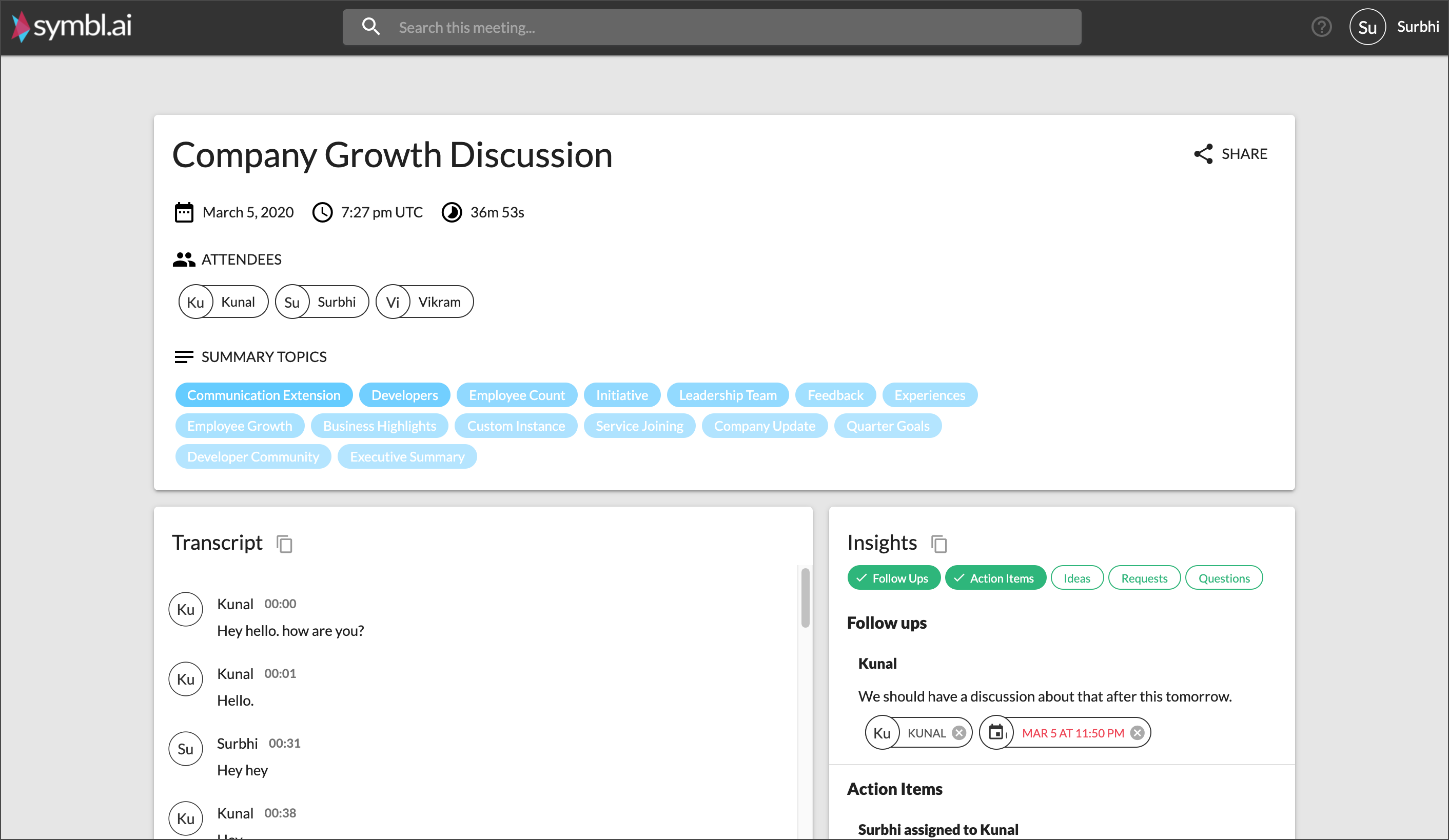Telephony API - SIP
This tutorial provides code snippets and instructions on how to utilize Python SDK to call Symbl's Telephony API using SIP. To view the source code, browse the open-source repository in GitHub.
The Python SDK provides the following capabilities:
-
Geting Conversation Intelligence and receive Insights on Email
-
Subscribing to Events (transcript, questions, action-items, etc.)
Credential Handling
The Python SDK simplifies the credential handling by allowing you to either add your credentials directly to the connection method's calls or else through a separate file saved to your execution directory.
To add your credentials directly to the connection method's calls, add the following line:
credentials={app_id: <app_id>, app_secret: <app_secret>},
To handle credentials through a separate file saved your execution directory, add a file to your project called symbl.conf with the following configuration:
[credentials]
app_id=
app_secret=
Start SIP Connection
The code snippet below allows you to start a Telephony connection with Symbl via SIP. It can make an outbound call to a phone number using SIP endpoints that can be accessed over the internet using a SIP URI:
import symbl
connection_object = symbl.Telephony.start_sip(uri="sip:[email protected]") # A valid SIP URI to dial in
The uri is the SIP addressing scheme that communicates who to call via the SIP.
Stop Connection
To stop an active Telephony connection, use the code given below:
import symbl
connection_object.stop()
Add the connectionId of the connection you want to terminate.
Optionally, you can also use parameters supported with Telephony API. This returns an updated connection object which will have the conversationId in the response.
Subscribe to Events
Once the SIP connection is established, you can get live updates on conversation events such as generation of transcript, action items or questions, etc.
The connection_object.subscribe is a function of the connection object that listens to the events of a live call and let's you subscribe to them in real-time. It takes a dictionary parameter, where the key can be an event and it's value can be a callback function that should be executed on the occurrence of that event.
Supported Events
Following are the functions for different events you can subscribe to:
| Event | Description |
|---|---|
message_response | Generates an event whenever transcription is available. |
insight_response | Generates an event whenever an action_item or question is identified in the message. |
tracker_response | Generates an event whenever a tracker is identified in the transcription. |
transcript_response | Also generates transcription values, however these will include an isFinal property which will be False initially meaning the transcription are not finalized. |
topic_response | Generates an event whenever a topic is identified in any transcription. |
Usage of Subscribe Event
connection_object.subscribe({
'transcript_response': lambda response: print('printing the first response ' + str(response)),
'insight_response': lambda response: print('printing the first response ' + str(response))
}
)
print(connection_object)
Receive Insights on Email
After the call has ended, you can trigger an email containing the URL to view the Transcripts, Topics, Speaker analytics, Follow-ups, Action Items and meeting insights in a single page Web Application in a single page Web Application- Symbl's Prebuilt Summary UI.
To receive the insights via email, use the code given below:
actions = [
{
"invokeOn": "stop",
"name": "sendSummaryEmail",
"parameters": {
"emails": [
emailId
],
},
},
]
emailId is the email address where Symbl will send the Conversation Insights.
A sample of the Insights email is given below:

Complete Sample Code
The sample code given below shows the usage of subscribe function and email action explained above:
import symbl
emailId = "[email protected]" #Your registered email ID on the conference tool.
connection_object = symbl.Telephony.start_sip(uri="sip:[email protected]",
actions = [
{
"invokeOn": "stop",
"name": "sendSummaryEmail",
"parameters": {
"emails": [
emailId
],
},
},
]
)
connection_object.subscribe({'transcript_response': lambda response: print('printing the first response ' + str(response)), 'insight_response': lambda response: print('printing the first response ' + str(response))})
Python SDK Reference
For a complete list of supported classes and objects in the Python SDK, see the Python SDK Reference page.
You can view more capabilities added to Telephony API in the following sections:
Updated over 2 years ago
